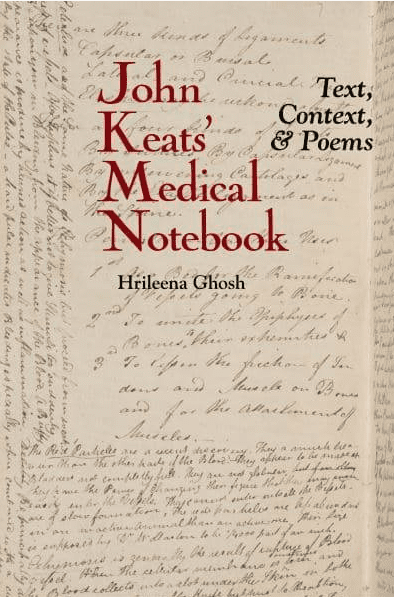Arpan K. Banerjee
Solihull, United Kingdom

February 23, 2021 marked the bicentenary of the death of the great Romantic poet John Keats. Born in 1795, Keats lived a tragically short life, dying at the age of only twenty-five. It is perhaps little known that he first qualified as an apothecary doctor before giving up medicine for a life devoted to poetry.
Keats lost his parents as a child and at the age of fourteen became apprenticed to a surgeon named Hammond in North London. He continued his medical training in 1815 at the United Hospitals of Guy’s and St. Thomas’ in South London, which were then in close proximity. It is there that he attended lectures in surgery and anatomy by the surgeon Astley Cooper, who took an avuncular interest in Keats and found him lodging near the hospital.
In John Keats’ Medical Notebook, author Hrileena Ghosh, an independent scholar, has researched Keats’ medical school notebook and other archives to analyze the influence that his life as a medical student had on his poetry. Keats’ meticulous lecture notes give insight into the creative process of this remarkable poet, as well as an idea of his working methods and the content of medical education at the time. Keats became a dresser to a mediocre surgeon, Mr. Lucas, but continued to attend operations by Astley Cooper, who was a brilliant surgeon and inspiring lecturer.
Keats’ first published poem, “To Solitude,” appeared in The Examiner on May 5, 1816 while he was still a medical student. His medical training also provided material for his longest poetical work, “Endymion,” written after he had passed the exams to be an apothecary but chose not to pursue medical practice in 1816. He remained undeterred when his first published collection of poetry was not well received in 1817. Over the next few years, he would produce masterpieces such as “Ode to a Nightingale,” “Ode to Autumn,” and “Ode on Melancholy.”
In John Keats’ Medical Notebook, the author has used extensive archival research to explore the details of Keats’ studies at Guy’s, including his poetic endeavors and friendships. We also learn how the medical ethics of the Romantic era influenced his writing and how medical vocabulary was used to portray visceral passion in his poetry.
When Keats’ health began to deteriorate from tuberculosis, he was advised by doctors to go to a warmer climate. He moved to a villa on the Spanish Steps in Rome, which is now the Keats-Shelley Memorial House and Museum. He died in 1821 at age twenty-five.
John Keats’ Medical Notebook is well written and well referenced with footnotes and a useful bibliography and index. A scholarly contribution to the literature about Keats, the book provides new insights and analyses of his medical student days and how medical training influenced his brilliant and remarkable poetry.
John Keats’ Medical Notebook
Hrileena Ghosh
Liverpool University Press, 2020
ISBN 9781789620610
Reference
- Banerjee AK. “John Keats: his medical student years at the United Hospitals of Guy’s and St Thomas’, 1815-1816.” J Royal Soc Med (82), 1989: 620-621.
ARPAN K. BANERJEE, MBBS (LOND), FRCP, FRCR, FBIR, qualified in medicine at St. Thomas’s Hospital Medical School, London. He was a consultant radiologist in Birmingham from 1995–2019. He served on the scientific committee of the Royal College of Radiologists 2012–2016. He was Chairman of the British Society for the History of Radiology from 2012–2017. He is Treasurer of ISHRAD and adviser to Radiopaedia. He is the author/co-author of numerous papers and articles on a variety of clinical medical, radiological, and medical historical topics and seven books including Classic Papers in Modern Diagnostic Radiology (2005) and The History of Radiology (OUP 2013).

Leave a Reply